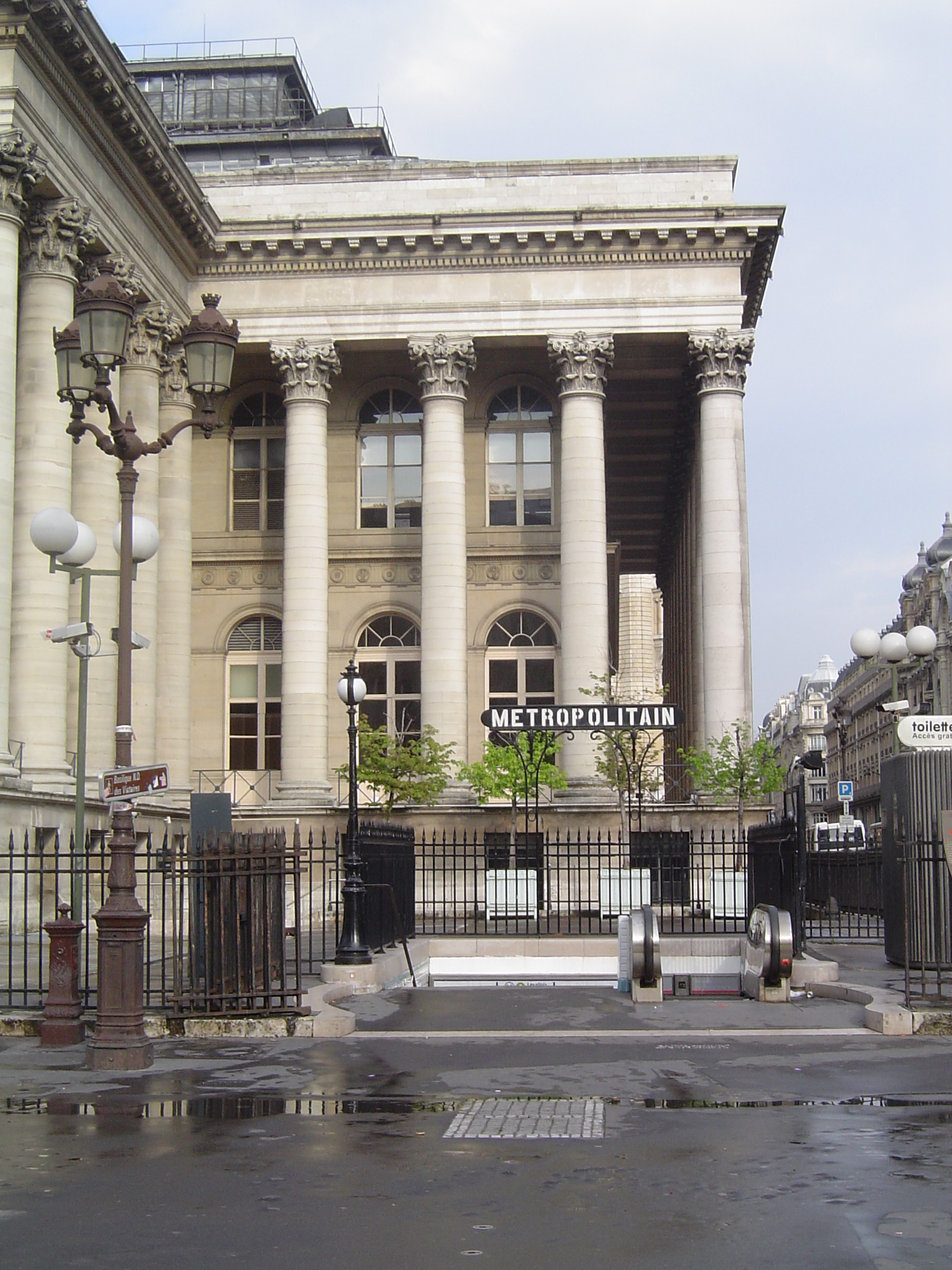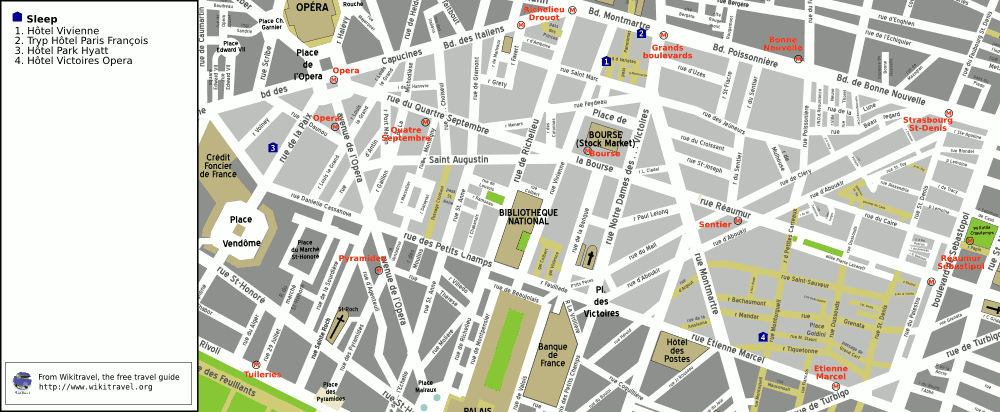|
Bourse (Paris Métro)
Bourse () is a station on Paris Métro Line 3, located in the 2nd arrondissement of Paris. Location The station is located under the axis of the Rue Quatre-Septembre and Réaumur, right next to Place de la Bourse. Oriented approximately along an east–west axis, it is located between Quatre-Septembre and Sentier stations. History It opened on 19 October 1904 as part of the first section of the line opened between Père Lachaise and Villiers. It is named after the nearby Bourse de Paris (stock exchange) of which it provides a service, and at the center of which is built the Palais Brongniart, then known as the Palais de la Bourse because it housed the Paris Stock Exchange at the time. The latter sat there from 1828 to 1998 before being integrated into Euronext. As part of the RATP's ''Metro Renewal'' program, the station's corridors were renovated on 11 July 2003, then the turn of the platforms in 2008. In 2019, 3,386,481 travelers entered this station which places it ... [...More Info...] [...Related Items...] OR: [Wikipedia] [Google] [Baidu] |
2nd Arrondissement Of Paris
The 2nd arrondissement of Paris (''IIe arrondissement'') is one of the 20 arrondissements of the capital city of France. In spoken French, this arrondissement is colloquially referred to as ''deuxième'' (second/the second). It is governed locally together with the 1st, 3rd and 4th arrondissement, with which it forms the 1st sector of Paris. Also known as Bourse, this arrondissement is located on the right bank of the River Seine. The 2nd arrondissement, together with the adjacent 8th and 9th arrondissements, hosts an important business district, centred on the Paris Opéra, which houses the city's most dense concentration of business activities. The arrondissement contains the former Paris Bourse (stock exchange) and several banking headquarters, as well as a textile district, known as the Sentier, and the Opéra-Comique's theatre, the Salle Favart. The 2nd arrondissement is the home of Grand Rex, the largest movie theater in Paris. The 2nd arrondissement is also the home ... [...More Info...] [...Related Items...] OR: [Wikipedia] [Google] [Baidu] |
Agence France-Presse
Agence France-Presse (; AFP) is a French international news agency headquartered in Paris, France. Founded in 1835 as Havas, it is the world's oldest news agency. With 2,400 employees of 100 nationalities, AFP has an editorial presence in 260 cities across 150 countries. Its main regional headquarters are based in Nicosia, Montevideo, Hong Kong and Washington, D.C. AFP publishes stories, videos, photos and graphics in French, English, Arabic, Portuguese, Spanish, and German. Two-thirds of its turnover comes from its own commercial activities, with the remaining one-third being provided by the French government (amounting to 113.3 million euros in 2022) as compensation for carrying out its mission of general interest. In December 2024, AFP was ranked as the 27th most visited news site in the world, with over 105 million monthly readers. History Agence France-Presse has its origins in the Agence Havas, founded in 1835 in Paris by Charles-Louis Havas, making it the world's ... [...More Info...] [...Related Items...] OR: [Wikipedia] [Google] [Baidu] |
Rue De Richelieu
The Rue de Richelieu () is a long street of Paris, starting in the south of the 1st arrondissement at the Comédie-Française and ending in the north of the 2nd arrondissement. For the first half of the 19th century, before Georges-Eugène Haussmann redefined Paris with grand boulevards, it was one of the most fashionable streets of Paris. It is notable for the National Library of France and for scattered coin dealers and currency changers, being near the Paris Bourse, the stock market. Name The street is named for the Cardinal de Richelieu, chief minister of King Louis XIII from 1624 to 1642. The street was originally called the Rue Royale and then Rue de Richelieu soon after. The name was changed to the Rue de la Loi in 1793 during the French Revolution; its name was restored to Richelieu in 1806. Notable buildings * Palais-Royal, a Richelieu residence () * , ''Site Richelieu'', a historical building () * Comédie-Française, main hall ( Salle Richelieu) * The old Faur ... [...More Info...] [...Related Items...] OR: [Wikipedia] [Google] [Baidu] |
Bibliothèque Nationale De France
The (; BnF) is the national library of France, located in Paris on two main sites, ''Richelieu'' and ''François-Mitterrand''. It is the national repository of all that is published in France. Some of its extensive collections, including books and manuscripts but also precious objects and artworks, are on display at the BnF Museum (formerly known as the ) on the Richelieu site. The National Library of France is a public establishment under the supervision of the Ministry of Culture. Its mission is to constitute collections, especially the copies of works published in France that must, by law, be deposited there, conserve them, and make them available to the public. It produces a reference catalogue, cooperates with other national and international establishments, as well as participates in research programs. History The National Library of France traces its origin to the royal library founded at the Louvre Palace by Charles V in 1368. Charles had received a collection o ... [...More Info...] [...Related Items...] OR: [Wikipedia] [Google] [Baidu] |
Paris Bourse
Euronext Paris, formerly known as the Paris Bourse (), is a regulated securities trading venue in France. It is Europe's second largest stock exchange by market capitalization, behind the London Stock Exchange, as of December 2023. As of 2022, the 795 companies listed had a combined market capitalization of over US$4.58 trillion. Since September 2000, the Paris Bourse has been part of Euronext, of which it was a co-founder together with the Amsterdam Stock Exchange and Brussels Stock Exchange. It was subsequently rebranded Euronext Paris. History The Paris stock market started taking shape in the early 18th century, and first acquired prominence with trading of John Law's Company from 1717 to 1721. In 1724, a government decree gave it its first permanent regulation and is occasionally though dubiously taken as the market's starting point. From the second half of the 19th century, official stock markets in Paris were operated by the ''Compagnie des agents de change'', dire ... [...More Info...] [...Related Items...] OR: [Wikipedia] [Google] [Baidu] |
Noctilien
Noctilien is the night bus service in Paris and its agglomeration. It is managed by the Île-de-France Mobilités (formerly the STIF), the Île-de-France regional public transit authority, and operated by RATP (with 32 lines) and Transilien SNCF (with 21 lines). It replaced the previous '' Noctambus'' service on the night of 20/21 September 2005, providing for a larger number of lines than before and claiming to be better adapted to night-time transport needs. In place of the previous hub-and-spoke scheme in which all buses terminated at and departed from the heart of Paris at Châtelet , Noctilien's new service includes buses operating between '' banlieues'' (the communes surrounding Paris proper) as well as outbound lines running from Paris' four main railway stations: Gare de l'Est, Gare de Lyon, Gare Montparnasse and Gare Saint-Lazare. In addition, these four stations are also connected to each other by a regular night bus service. Noctilien operates 53 bus lines ove ... [...More Info...] [...Related Items...] OR: [Wikipedia] [Google] [Baidu] |
Cyan
Cyan () is the color between blue and green on the visible spectrum of light. It is evoked by light with a predominant wavelength between 500 and 520 nm, between the wavelengths of green and blue. In the subtractive color system, or CMYK color model, which can be overlaid to produce all colors in paint and color printing, cyan is one of the primary colors, along with magenta and yellow. In the additive color system, or RGB color model, used to create all the colors on a computer or television display, cyan is made by mixing equal amounts of green and blue light. Cyan is the complement of red; it can be made by the removal of red from white. Mixing red light and cyan light at the right intensity will make white light. It is commonly seen on a bright, sunny day in the sky. Shades and variations Different shades of cyan can vary in terms of hue, chroma (also known as saturation, intensity, or colorfulness), or lightness (or value, tone, or brightness), or any combinat ... [...More Info...] [...Related Items...] OR: [Wikipedia] [Google] [Baidu] |
Parisine
Parisine is a typeface that was created by Jean-François Porchez and is distributed by Typofonderie. The typeface is used in Paris Métro, tramways and buses and the parts of RER parts that are operated by the RATP Group in Île-de-France. In 2015, the Osaka City Subway in Japan adopted Parisine as the Latin-character component of its new signage system, which is gradually being introduced throughout its network. Parisine The font was originally developed in 1996 as a custom typeface in Bold and Bold Italic developed for the RATP to improve signage legibility and space economy. The design was based on the proportions of Helvetica Bold but is condensed at 90%. In 1999, the font was extended to a font family for multiple uses like communication material and maps. In 2000, hinted TrueType versions were added for internal corporate use. The name Parisine is a trademark of the RATP. Parisine Std Parisine Std is an OpenType variant of Parisine. A small caps version was produce ... [...More Info...] [...Related Items...] OR: [Wikipedia] [Google] [Baidu] |
Sentier (Paris Métro)
Sentier () is a station on Line 3 of the Paris Métro in the 2nd arrondissement. Location The station is located under Rue Réaumur, at the intersection with Rue de Cléry and Rue du Sentier. Oriented, approximately, along an east–west axis, it is located between the Bourse and Réaumur - Sébastopol stations. History The station opened on 20 November 1904 as part of the first section of the line between Père Lachaise and Villiers, which opened a month earlier. The station is named after a path (French: ''Sentier'') leading to the city's fortifications, now called the Rue du Sentier, which gave its name to the Sentier district, known until recently for the activities in the textile trades that developed there from the 1950s. The station is one of the few to have its entrance incorporated into the front of a building. A secondary entrance is located 87 Rue Réaumur; it contains railings designed by Hector Guimard and is listed as a ''monument historique''. Since the 1960s ... [...More Info...] [...Related Items...] OR: [Wikipedia] [Google] [Baidu] |
Gallieni (Paris Métro)
Gallieni (Parc de Bagnolet) () is a station on Paris Métro Line 3, being its eastern Terminal train station, terminus. Location The station is located under the Paris-Gallieni International Bus Station, in the heart of a motorway complex at the junction of the A3 autoroute and the Boulevard Périphérique Paris ring-road. Oriented along an east–west axis, it is preceded by or followed by the Porte de Bagnolet (Paris Métro), Porte de Bagnolet metro station. History It was opened on 2 April 1971 when the line was extended from Gambetta (Paris Métro), Gambetta in order to improve the service to the town of Bagnolet. It has since been the new eastern terminus, replacing the previous terminus at Porte des Lilas, the section between the latter and Gambetta station, disconnected since 27 March 1971 and became the current line 3 bis. It is situated on the ''Avenue Gallieni'', which is named after General Joseph Gallieni, famous for commandeering 600 taxis to take troops to the fron ... [...More Info...] [...Related Items...] OR: [Wikipedia] [Google] [Baidu] |




